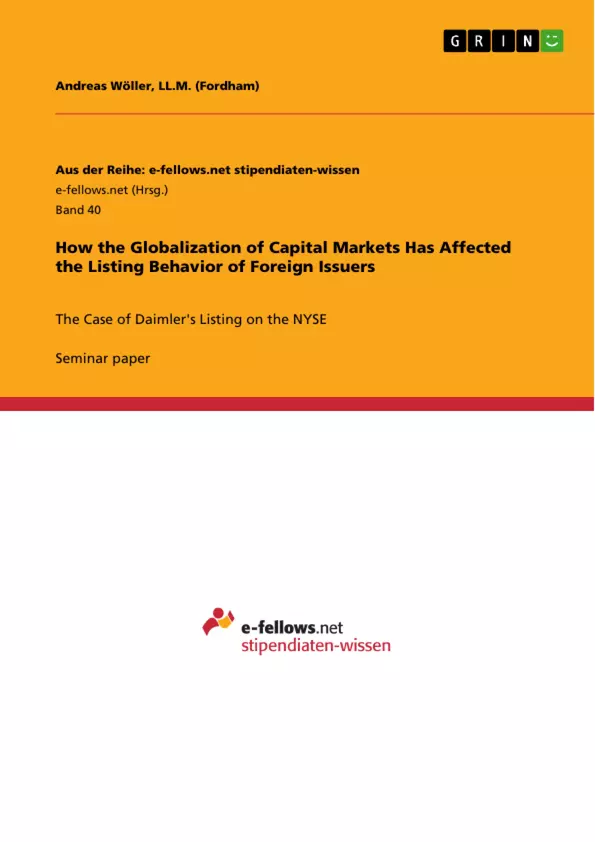This case study on Daimler’s history on the NYSE aims to illustrate how global equity markets have evolved in the past two decades and what the reasons are for companies to raise capital in these global markets. In doing so, the case study proceeds as follows: After a brief introduction in Part I, Part II describes the initial listing of Daimler ADRs on the NYSE in October 1993 and its consequences for Daimler’s financial reporting, followed by the reasons that motivated Daimler to come to New York. Part III provides an overview of the legislative and regulatory changes that took place both in Germany and the U.S., and how these developments affected Daimler’s decision to terminate its listing on the NYSE in 2010. Part IV investigates how investors today are able to invest in foreign issuers such as Daimler. Finally, the case study concludes by summarizing the reasons for Daimler’s delisting and its meaning for the competitiveness of the U.S. public markets in Part V.
Inhaltsverzeichnis (Table of Contents)
- I. INTRODUCTION
- II. LISTING ON THE NYSE AND ITS CONSEQUENCES
- A. DAIMLER'S ADR LISTING
- B. CONSEQUENCES FOR DAIMLER
- C. DAIMLER'S REASONS FOR LISTING
- 1. LIQUIDITY
- 2. PRESTIGE
- 3. BONDING
- 4. DAIMLER'S NEED FOR RESTRUCTURING
- III. LEGISLATIVE CHANGES IN GERMANY AND THE U.S.
- A. REFORM OF THE GERMAN FINANCIAL MARKETS
- 1. THE SECURITIES TRADING ACT (1994)
- 2. THE TAKEOVER ACT (2002)
- B. IAS/IFRS
- C. SARBANES-OXLEY AND ITS GERMAN COUNTERPARTS
- 1. SOX'S CORE PROVISIONS
- 2. INCONSISTENCIES/CONFLICTS WITH GERMAN LAW
- 3. DUAL COMPLIANCE COST
- A. REFORM OF THE GERMAN FINANCIAL MARKETS
- IV. TRADING IN DAIMLER SHARES TODAY
- A. DELISTING REQUIREMENTS
- B. CHANGED INVESTOR BEHAVIOR
- C. ADR PROGRAM
- V. CONCLUSION
Zielsetzung und Themenschwerpunkte (Objectives and Key Themes)
This paper analyzes the factors that led to Daimler-Benz AG's decision to list its American Depository Receipts (ADRs) on the New York Stock Exchange (NYSE) in 1993 and ultimately delist them in 2010. It explores the consequences of Daimler's listing for the company and the broader trends of German companies listing and delisting on the NYSE.
- The impact of the globalization of capital markets on listing behavior of foreign issuers
- The case of Daimler's listing on the NYSE and its subsequent delisting
- The reasons behind Daimler's decision to list and delist, including liquidity, prestige, bonding, and the need for restructuring
- The role of legislative changes in Germany and the U.S., such as the Securities Trading Act (1994), the Takeover Act (2002), and Sarbanes-Oxley Act (SOX), on cross-listing decisions
- The changing investor behavior and trading volume in Daimler shares, leading to the delisting decision
Zusammenfassung der Kapitel (Chapter Summaries)
- I. INTRODUCTION: This chapter introduces the topic of Daimler's listing on the NYSE, highlighting the significance of the event and its implications for German companies. It discusses the initial enthusiasm surrounding the listing and the contrasting reactions from other German companies.
- II. LISTING ON THE NYSE AND ITS CONSEQUENCES: This chapter examines the consequences of Daimler's ADR listing for the company, including increased liquidity, enhanced prestige, and the potential to utilize U.S. securities for acquisitions. It delves into Daimler's reasons for seeking a listing, including its desire for greater liquidity, prestige, and bonding through compliance with U.S. disclosure standards. The chapter also discusses Daimler's need for restructuring as a contributing factor.
- III. LEGISLATIVE CHANGES IN GERMANY AND THE U.S.: This chapter analyzes the role of legislative changes in Germany and the U.S. on cross-listing decisions. It discusses the reform of the German financial markets, including the Securities Trading Act (1994) and the Takeover Act (2002). It also examines the impact of the adoption of International Financial Reporting Standards (IAS/IFRS) and the implementation of Sarbanes-Oxley (SOX) and its German counterparts.
- IV. TRADING IN DAIMLER SHARES TODAY: This chapter explores the current trading dynamics of Daimler shares, focusing on the delisting requirements and the impact of changed investor behavior. It discusses the evolution of Daimler's ADR program and its current status on the OTC market. The chapter also examines the broader trend of delistings by foreign issuers on the NYSE.
Schlüsselwörter (Keywords)
This paper focuses on the globalization of capital markets, the listing behavior of foreign issuers, the case of Daimler's listing on the NYSE, the consequences of cross-listing, legislative changes in Germany and the U.S., investor behavior, and delisting trends.
- Quote paper
- Andreas Wöller, LL.M. (Fordham) (Author), 2011, How the Globalization of Capital Markets Has Affected the Listing Behavior of Foreign Issuers, Munich, GRIN Verlag, https://www.hausarbeiten.de/document/174214


